Towards Resilient Cities: Optimizing Shelter Site Selection and Disaster Prevention Life Circle Construction Using GIS and Supply-Demand Considerations
Abstract
1. Introduction
2. Materials and Methods
2.1. Study Area
2.2. Data Sources and Processing
2.2.1. Road Network Vector Data and Points of Interest Data
2.2.2. Population Raster Data
2.2.3. Area of Interest Data and Site Area Data
2.2.4. Digital Elevation Model Data and Building Height Data
2.3. Research Methods
2.3.1. ArcGIS Network Analysis and Location Assignment
2.3.2. Reachability Evaluation of Gaussian Two-Step Floating Catchment Area Method Based on Time Cost
2.3.3. Weighted Voronoi Diagram
3. Results
3.1. Road Traffic Network Model in Times of Disaster
3.1.1. Assessing the Risk of Urban Building Collapse
3.1.2. Assessment of Flooding Hazards in Urban Areas
3.1.3. Constructing a Road Network Model with Time Cost for Disaster Time
3.2. Optimizing the Location of Emergency Shelters
3.2.1. Selection of Potential Emergency Shelters
3.2.2. Optimizing the Location of Emergency Shelters
3.3. Accessibility Analysis of Emergency Shelters Based on Gaussian Two-Step Floating Catchment Area Method
3.3.1. Evaluation of the Accessibility of Resident Emergency Congregate Shelters
3.3.2. Evaluation of Accessibility of Emergency Evacuation and Embarkation Shelters
3.4. Delineation of Disaster-Proof Life Circle Area Based on Weighted Voronoi Diagrams
4. Discussion
5. Conclusions
Author Contributions
Funding
Institutional Review Board Statement
Informed Consent Statement
Data Availability Statement
Acknowledgments
Conflicts of Interest
References
- Opinions on Promoting Green Development of Urban and Rural Construction Issued by the General Office of the CPC Central Committee and the State Council_Related Documents of the Central Government_Chinese Government Website. Available online: https://www.gov.cn/zhengce/2021-10/21/content_5644083.htm (accessed on 19 February 2024).
- By 2024, China will Carry out Comprehensive Urban Medical Checkups in Cities of Prefectural Level and above_Departmental News_Chinese Government. Available online: https://www.gov.cn/lianbo/bumen/202311/content_6917507.htm (accessed on 19 February 2024).
- Guo, W.; Lu, Y.; Zhai, G. Domestic and Overseas Research Progress and Trend on Resilient City. Shanghai Urban Plan. Rev. 2022, 8–15. [Google Scholar] [CrossRef]
- Li, Y.; Chai, Y.; Ta, N. From Disaster Prevention Life Circle to Safety Life Circle: Japanese Experience and Inspirations for China. Urban Plan. Int. 2022, 37, 113–120. [Google Scholar]
- Department of Natural Resources. Spatial Planning Guidance to Community Life Unit; Ministry of Natural Resources of the People’s Republic of China: Beijing, China, 2021; p. 37.
- Zhang, Y.; Zheng, L.; Gao, J. Earthquake Prevention Planning: Xichang Example. Planners 2011, 27, 19–25. [Google Scholar]
- Tang, S.; Wang, J.; Xu, Y.; Chen, S.; Zhang, J.; Zhao, W.; Wang, G. Evaluation of Emergency Shelter Service Functions and Optimisation Suggestions—Case Study in the Songyuan City Central Area. Sustainability 2023, 15, 7283. [Google Scholar] [CrossRef]
- Shi, L.; Zheng, Q.; Yang, M.; Liu, L. A review of definitions, influence factors and assessment of urban resilience. Acta Ecol. Sin. 2022, 42, 6016–6029. [Google Scholar]
- Capano, G.; Woo, J.J. Resilience and robustness in policy design: A critical appraisal. Policy Sci. 2017, 50, 399–426. [Google Scholar] [CrossRef]
- Simone, F.; Akel, A.J.N.; Di Gravio, G.; Patriarca, R. Thinking in systems, sifting through simulations: A way ahead for cyber resilience assessment. IEEE Access 2023, 11, 11430–11450. [Google Scholar] [CrossRef]
- De Nicola, A.; Villani, M.L.; Sujan, M.; Watt, J.; Costantino, F.; Falegnami, A.; Patriarca, R. Development and measurement of a resilience indicator for cyber-socio-technical systems: The allostatic load. J. Ind. Inf. Integr. 2023, 35, 100489. [Google Scholar] [CrossRef]
- Di Nardo, M.; Clericuzio, M.; Murino, T.; Madonna, M.J. An adaptive resilience approach for a high capacity railway. Int. Rev. Civ. Eng. 2020, 11, 98–105. [Google Scholar] [CrossRef]
- Dimitrova, M.; Snair, M. Classifying disaster risk reduction strategies: Conceptualizing and testing a novel integrated approach. Glob. Health 2024, 20, 7. [Google Scholar] [CrossRef]
- Kim, N.-Y.; Chung, J.-B. Disaster Resilience of Korean Cities Using Data Envelopment Analysis. Nat. Hazards Rev. 2024, 25, 04024003. [Google Scholar] [CrossRef]
- Chen, X.; Wang, P.; Fu, Z. Study on layout optimization of fixed refuge in mountainous city based on disaster risk assessment—Take Dongchuan district for example. J. Nat. Disasters 2020, 29, 162–174. [Google Scholar]
- Zhang, X.; Yu, S.; Zhang, X. Optimized Location Model of Resident Emergency Congregate Shelter Based on Multi-Objective Constraints. Urban Dev. Stud. 2020, 27, 59–66. [Google Scholar]
- Zhou, A.; Chen, L.; Zhu, H.; Chen, S. Reasonability of spatial distribution for urban emergency shelter in central district of Beijing at community scale. J. Saf. Environ. 2021, 21, 1662–1669. [Google Scholar]
- Li, G.; Ma, D.; Su, J. Weighted Voronoi Diagrams for Responsibility Space Regionalization of Urban Earthquake Emergency Shelters. Build. Sci. 2006, 55–59. [Google Scholar] [CrossRef]
- Ma, Y.; Xu, W.; Zhao, X. Assessment of allocation of residents to emergency shelters under different earthquake damage scenarios—Case study on central area of Beijing. China Saf. Sci. J. 2014, 24, 137–143. [Google Scholar]
- The State Council of the People’s Republic of China. Opinions on Promoting Urbanization with County Cities as Important Carriers; The State Council of the People’s Republic of China: Beijing, China, 2022.
- He, L.; Xie, Z. Towards Resilience: Review and Prospects of Urban Integrated Disaster Prevention Planning. Build. Sci. 2021, 43–54. [Google Scholar] [CrossRef]
- Xue, F.; Gao, X.; Qian, J.; Shen, D. Numerical Simulation of Urban Waterlogging Based on GIS. Geomat. Spat. Inf. Technol. 2012, 35, 12–14. [Google Scholar]
- Guo, J.; Zhang, Y.; Ji, J.; Yuan, X.; Xiao, B. A Preliminary Study on the Method of Seismic Intensity Assessment Based on Residential Building Data and High Resolution Remote Sensing Images. Seismol. Geol. 2020, 42, 968–980. [Google Scholar]
- Yang, H.; Yang, N.; Kong, F.; Zeng, J. Spatial Accessibilities Evaluation of Compulsory Education at County Level Based on Improved Two-Step Floating Catchment Area Method-Taking Jianli County of Hubei Province as an Example. J. Fudan Univ. (Nat. Sci.) 2021, 60, 618–625. [Google Scholar]
- Wang, M.; Chen, C.; Zhou, S. Accessibility of urban green open space based on weighted two-step floatingcatchment area method: A case study of the central district of Nanjing City. Acta Ecol. Sin. 2023, 43, 1–10. [Google Scholar]
- Bai, Z.; Wang, J.; Yang, F. Research progress in spatialization of population data. Prog. Geogr. 2013, 32, 1692–1702. [Google Scholar]
- Lee, Y.H.; Lee, J.S.; Baek, S.C.; Hong, W.H. Spatial Equity with Census Population Data vs. Floating Population Data: The Distribution of Earthquake Evacuation Shelters in Daegu, South Korea. Sustainability 2020, 12, 8046. [Google Scholar] [CrossRef]
- Bai, Z.; Wang, J.; Wang, M.; Gao, M.; Sun, J. Accuracy Assessment of Multi-Source Gridded Population Distribution Datasets in China. Sustainability 2018, 10, 1363. [Google Scholar] [CrossRef]
- Wu, W.; Ma, J.; Banzhaf, E.; Meadows, M.; Yu, Z.; Guo, F.; Sengupta, D.; Cai, X.-X.; Zhao, B. A first Chinese building height estimate at 10 m resolution (CNBH-10 m) using multi-source earth observations and machine learning. Remote Sens. Environ. 2023, 291, 113578. [Google Scholar] [CrossRef]
- Que, Z.; Hu, H.; Chen, S. Analysis of the Optimization in Urban Fire Station Layout Planning Based on Location-Allocation of GIS. Beijing Surv. Mapp. 2013, 18–24. [Google Scholar] [CrossRef]
- De, T.; Yiyu, S.; Miaomiao, X. Evaluation of green space accessibility based on improved Gaussian two-step floating catchment area method: A case study of Shenzhen City, China. Prog. Geogr. 2021, 40, 1113–1126. [Google Scholar]
- Wang, D. Study on the Division of Responsibility Area of Emergency Shelters in the Main Urban District of Nanjing Based on Weighted Voronoi Diagram. Master’s Thesis, Nanjing University of Technology, Nanjing, China, 2018. [Google Scholar]
- Zeng, S.; Chen, Z. Study on Urban System Spatial Structure and Attractive Scope by Voronoi Way: A Case of Guangdong Province. J. South China Norm. Univ. (Nat. Sci. Ed.) 2017, 49, 87–94. [Google Scholar]
- Rainstorm Popularization I. Rainstorm and Its Definition-China Meteorological Administration Government Portal. Available online: https://www.cma.gov.cn/2011xwzx/2011xqxxw/2011xqxyw/202110/t20211030_4058957.html (accessed on 10 January 2024).
- Tian, Z. Community Disaster Prevention Planning Method Based on Precaution Living Perimeter Theory. Ph.D. Thesis, Shandong University of Architecture, Zibo, China, 2019. [Google Scholar]
- Zhao, X.; Hu, L.; Wang, X.; Wu, J. Study on Identification and Prevention of Traffic Congestion Zones Considering Resilience-Vulnerability of Urban Transportation Systems. Sustainability 2022, 14, 16907. [Google Scholar] [CrossRef]
- Wenjun, M.; Liang, L.; Yizeng, W.; Qiao, H.; Jian, S. Physical Evaluation of Community-Life Circle for Health, Safety, and HighDensity Cities Governance. J. Tongji Univ. (Nat. Sci.) 2022, 50, 1628–1636. [Google Scholar]
- GB 21734-2008; Emergeney Shelter for Earthquake Disasters—Site and Its Facilities, China. 2008. Available online: http://c.gb688.cn/bzgk/gb/showGb?type=online&hcno=8B2E0D7D4505370BA2CAD64253A354F3 (accessed on 22 January 2024).
- Wei, L.; Chengxu, L.; Yaping, M. Division of responsibility areas for urban emergency shelters based on aGIS location-allocation analysis. J. Tsinghua Univ. (Sci. Technol.) 2022, 62, 1102–1109. [Google Scholar]
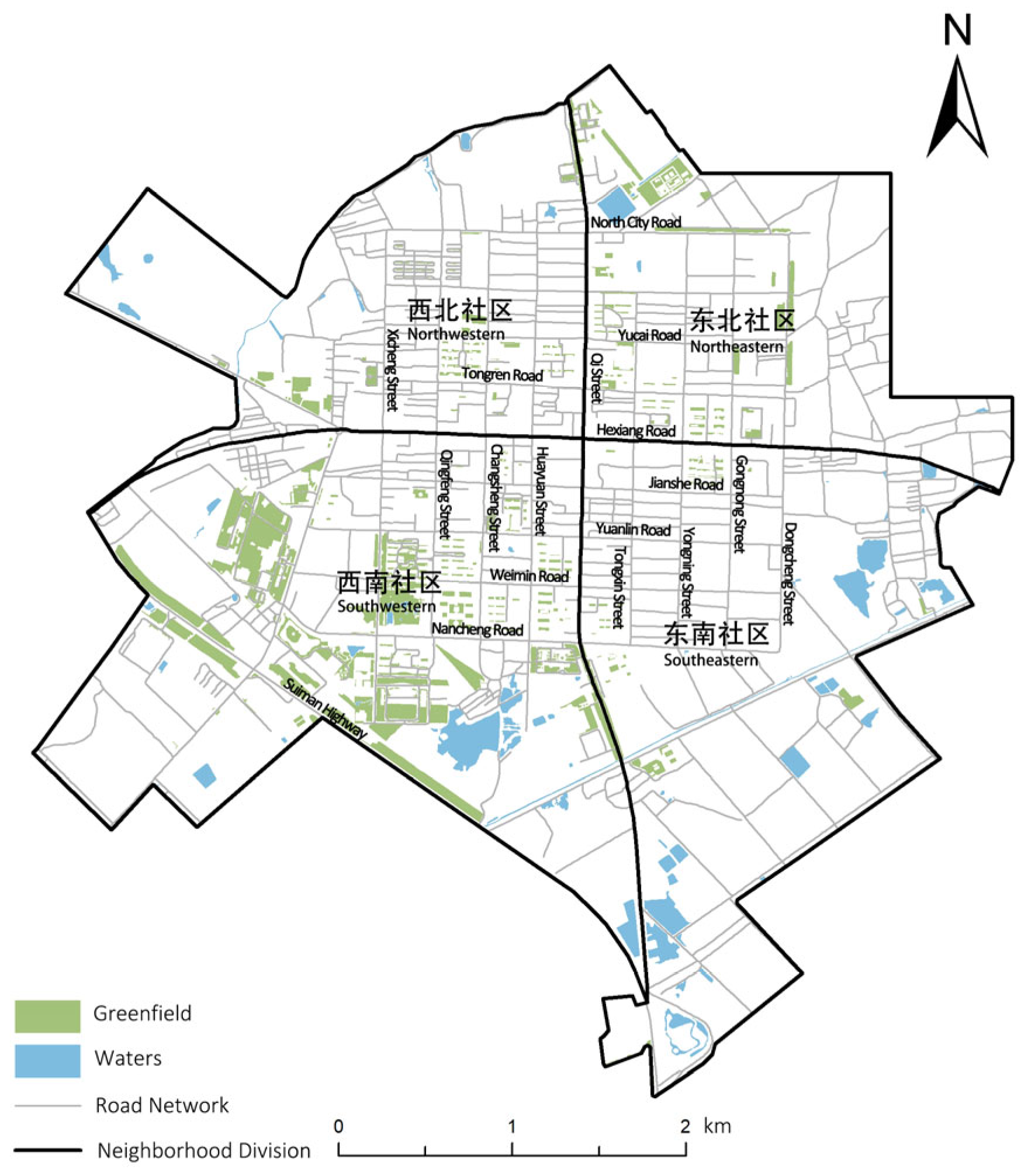
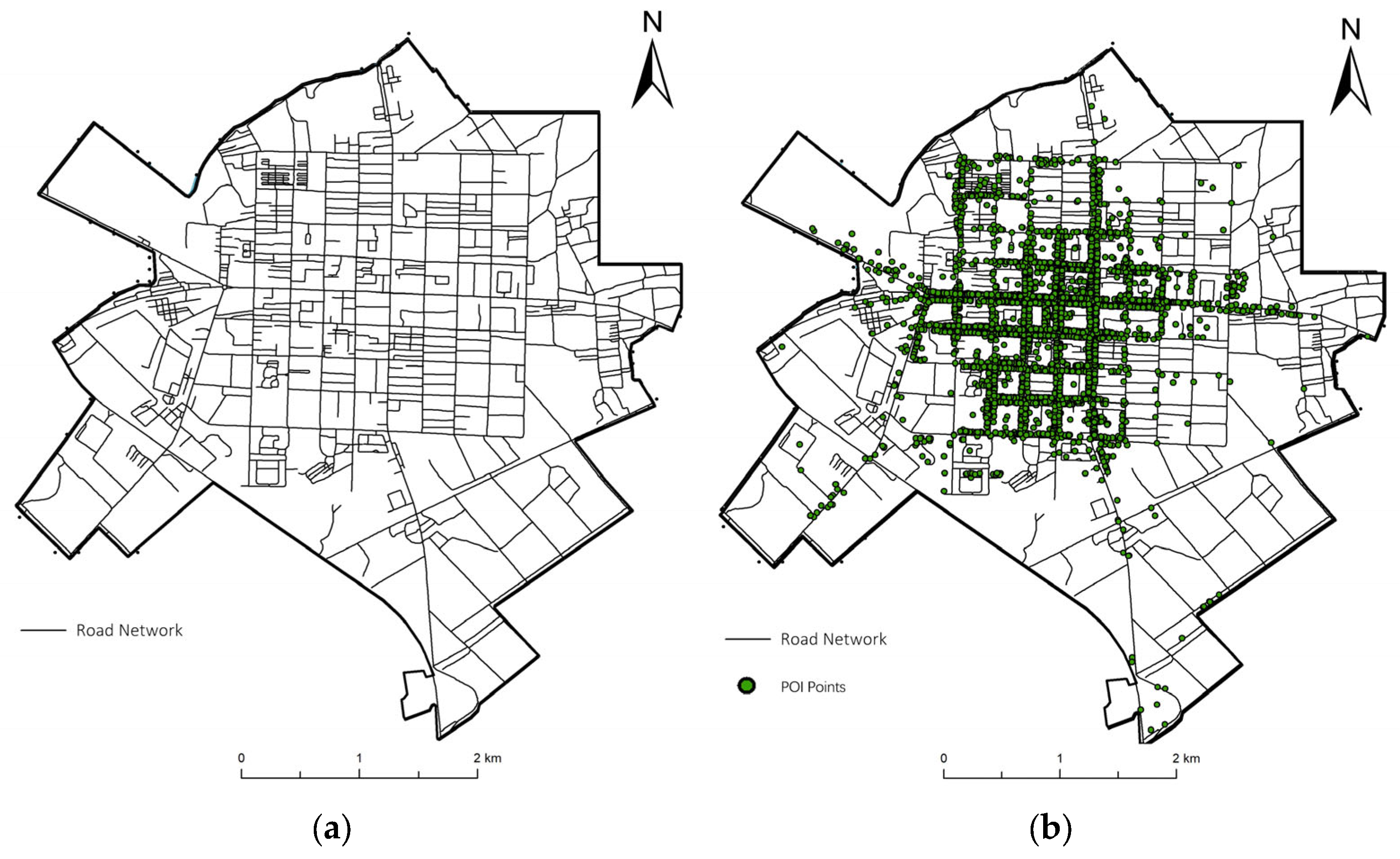
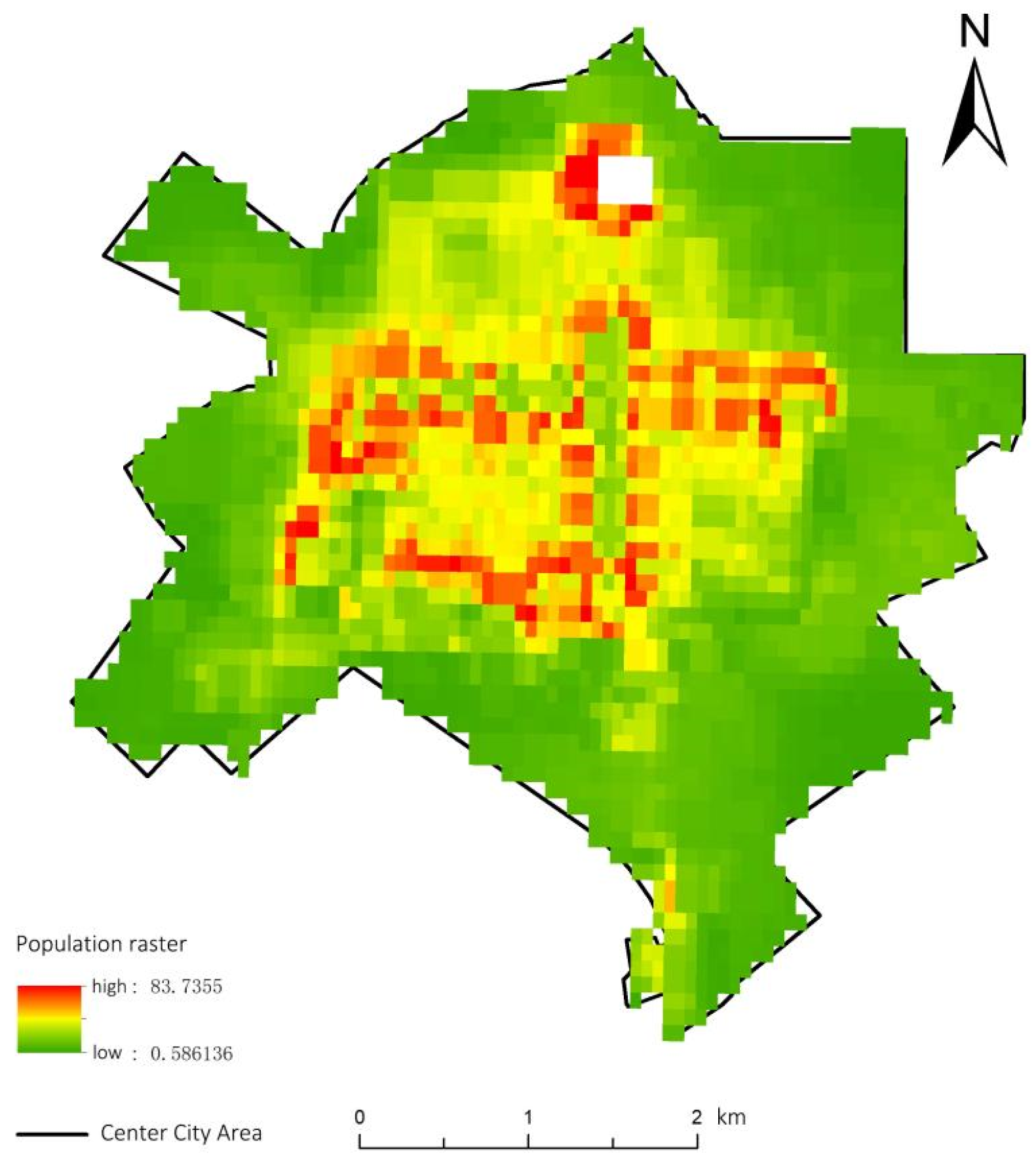
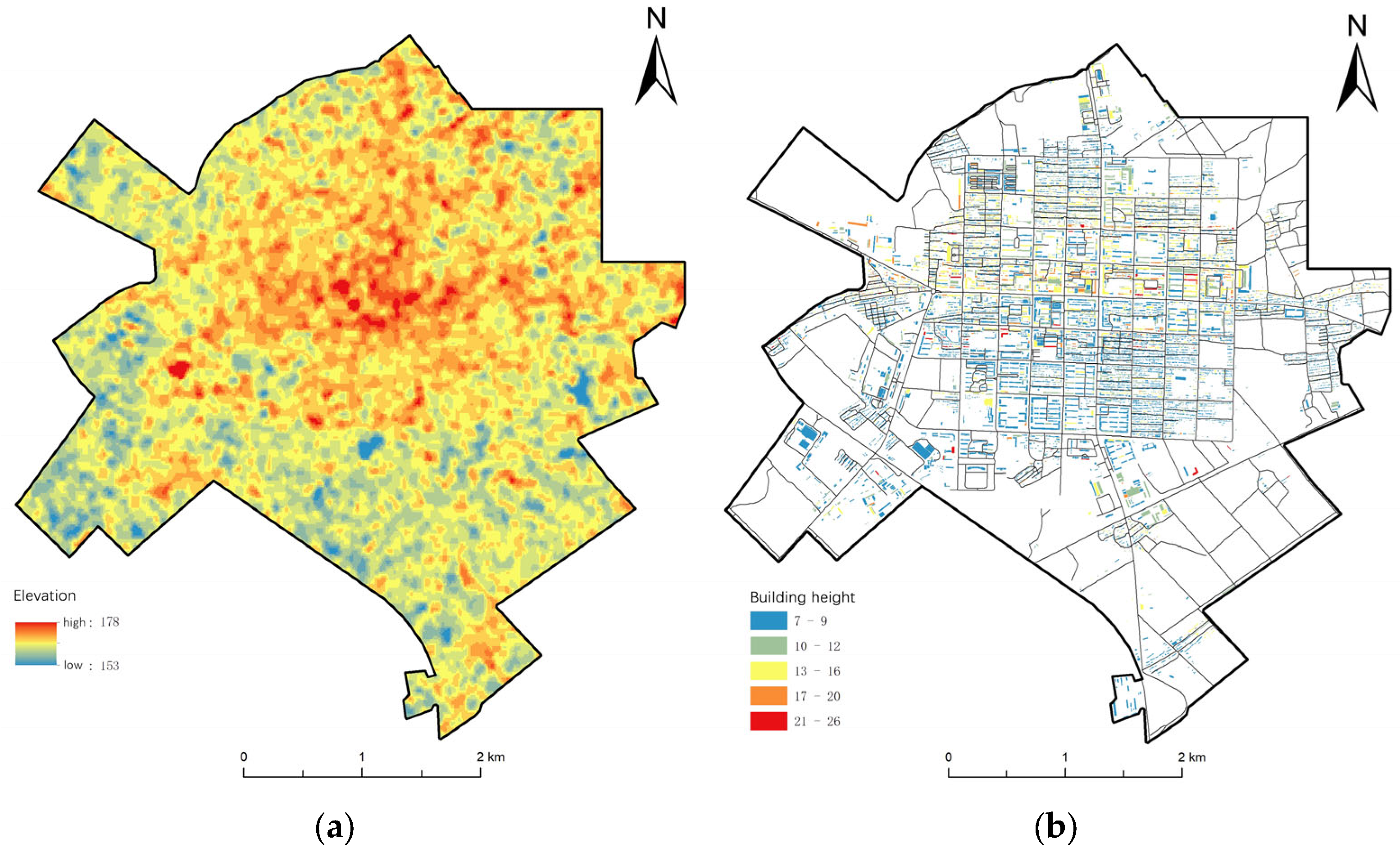
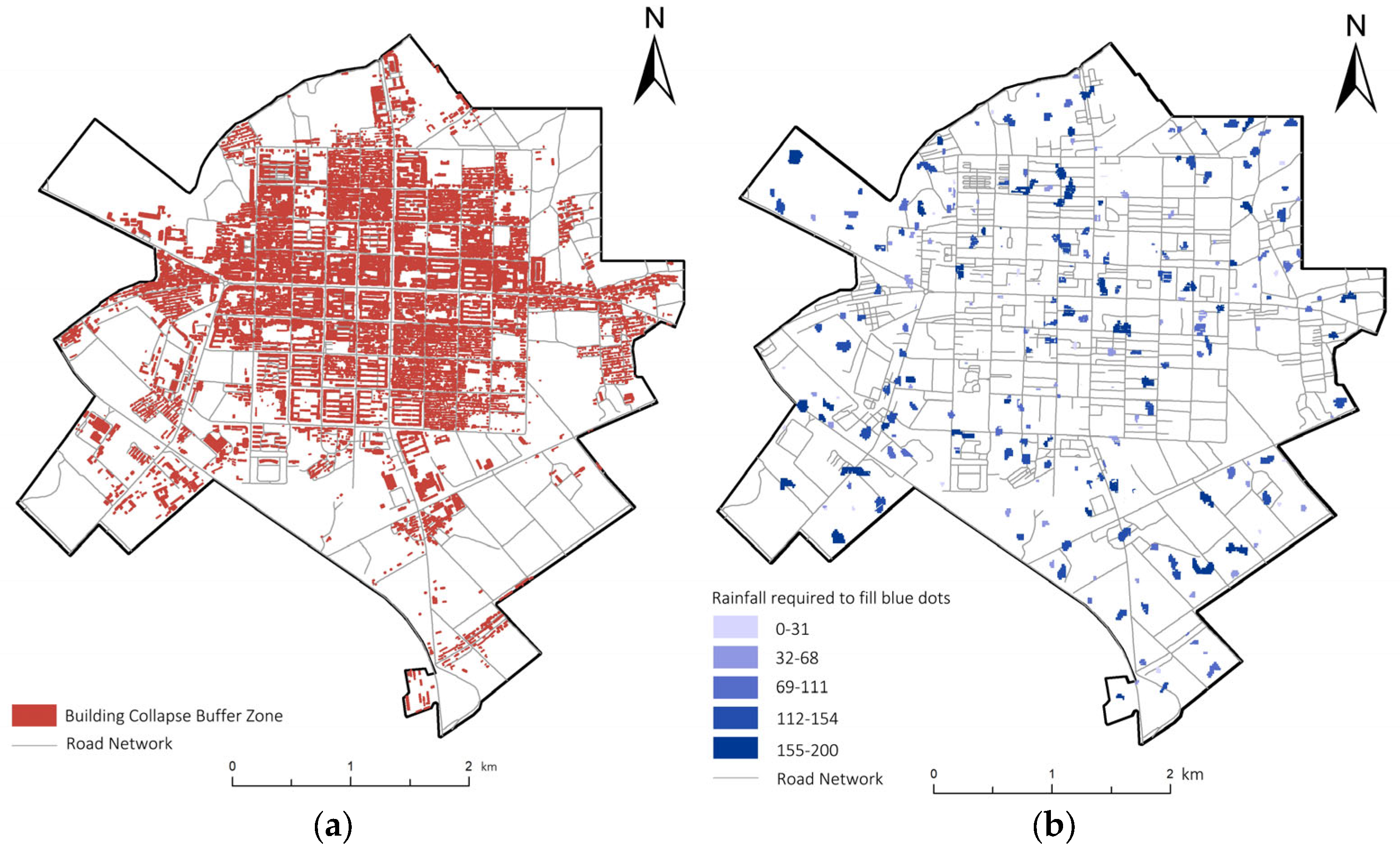
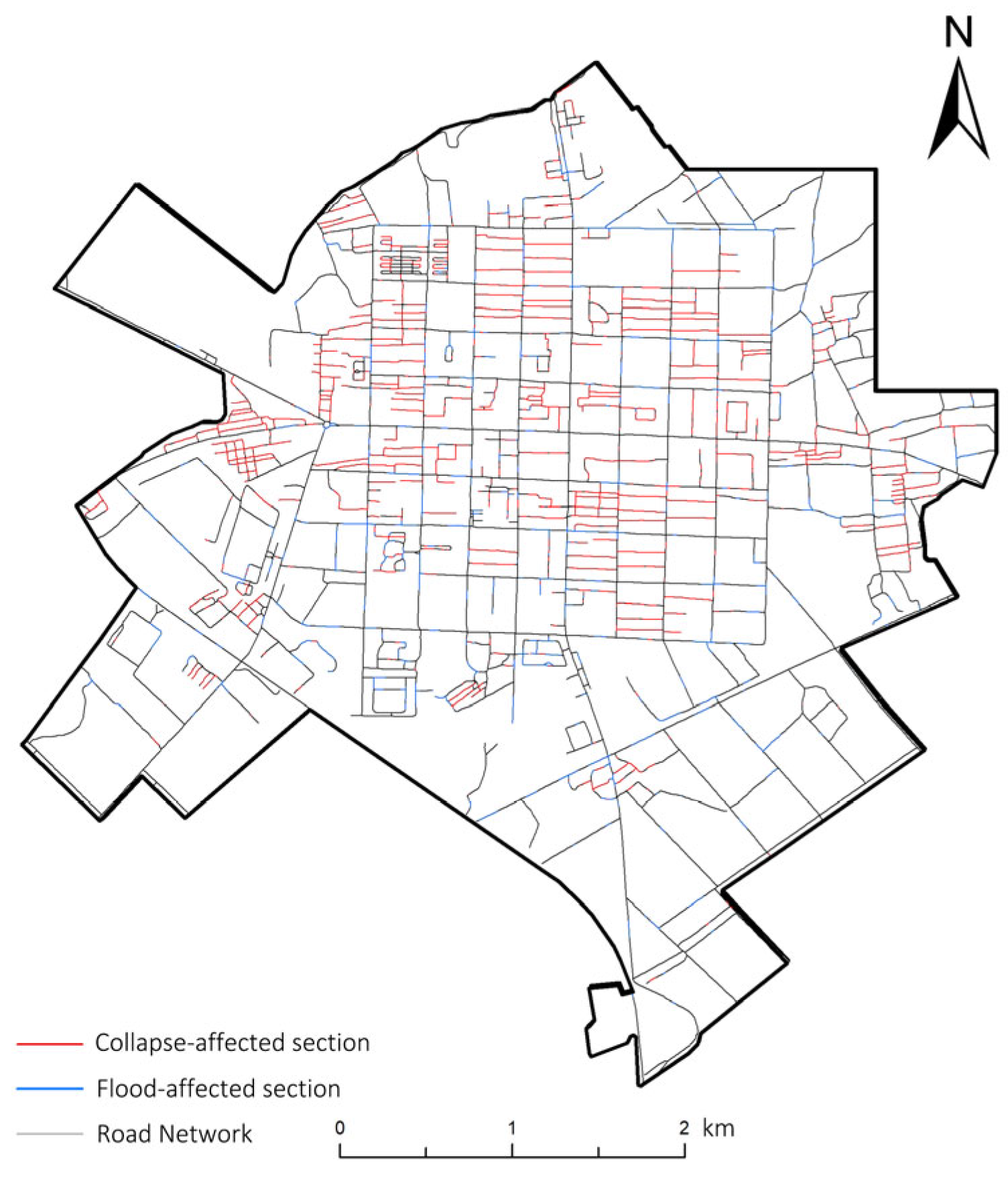

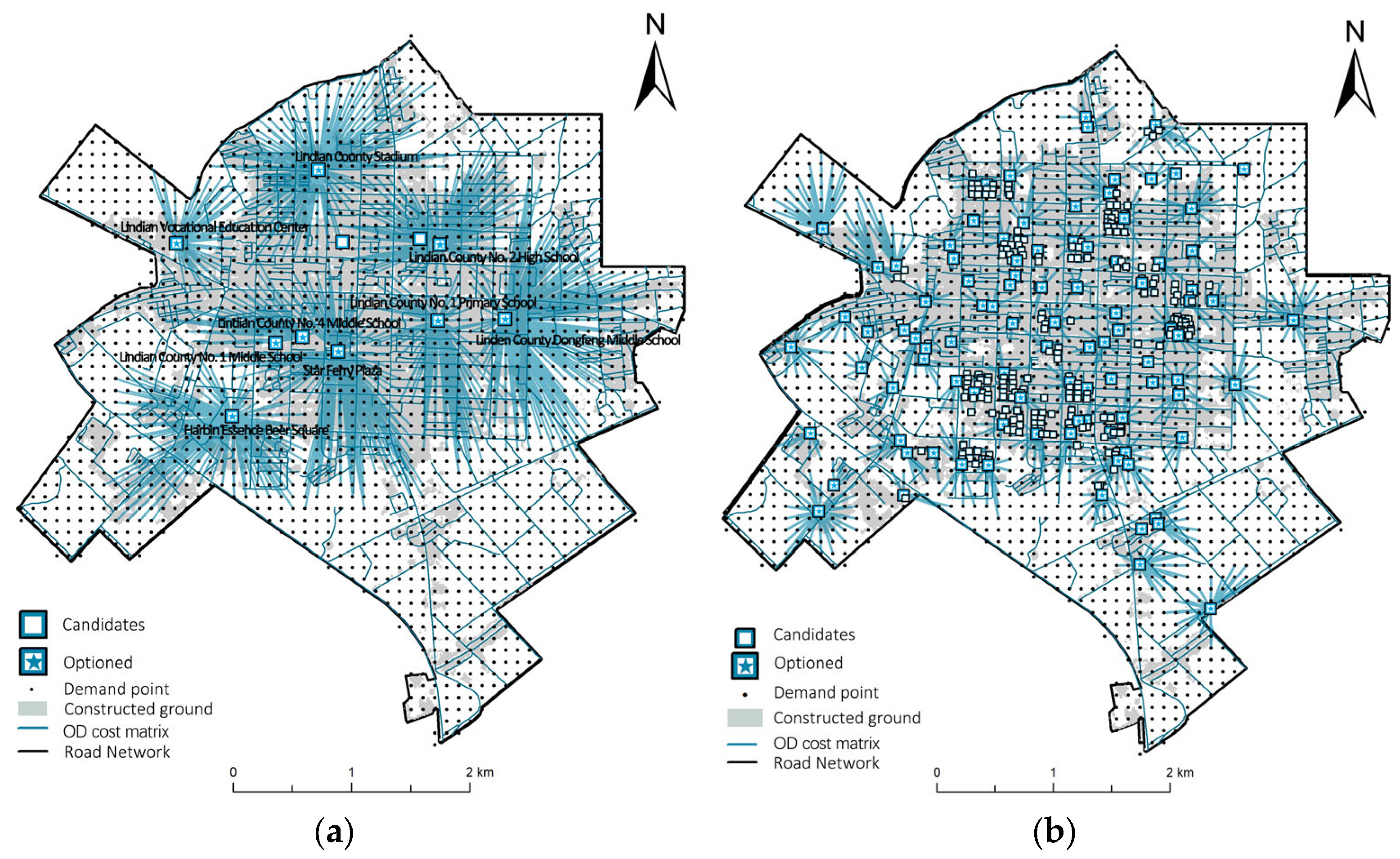
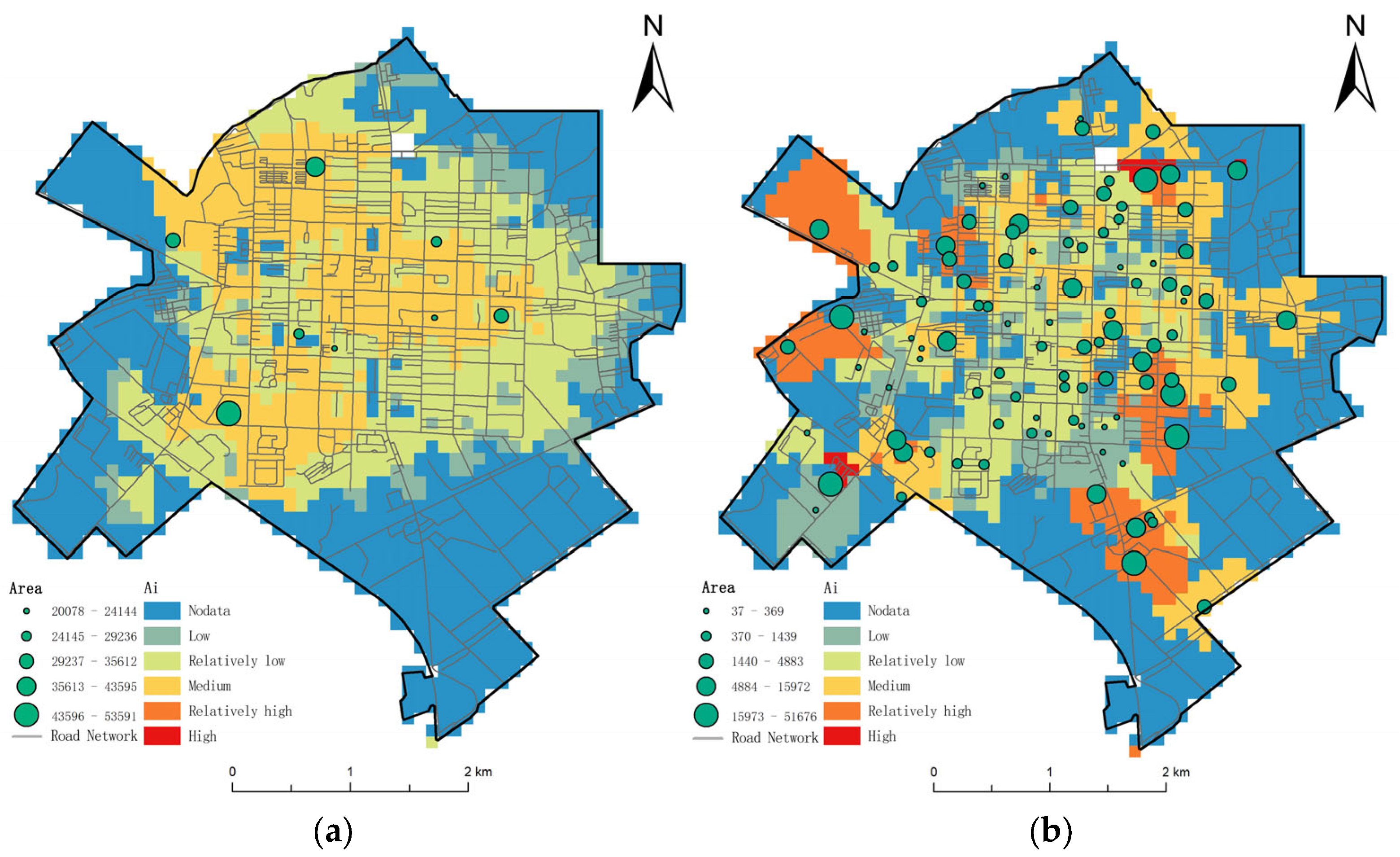
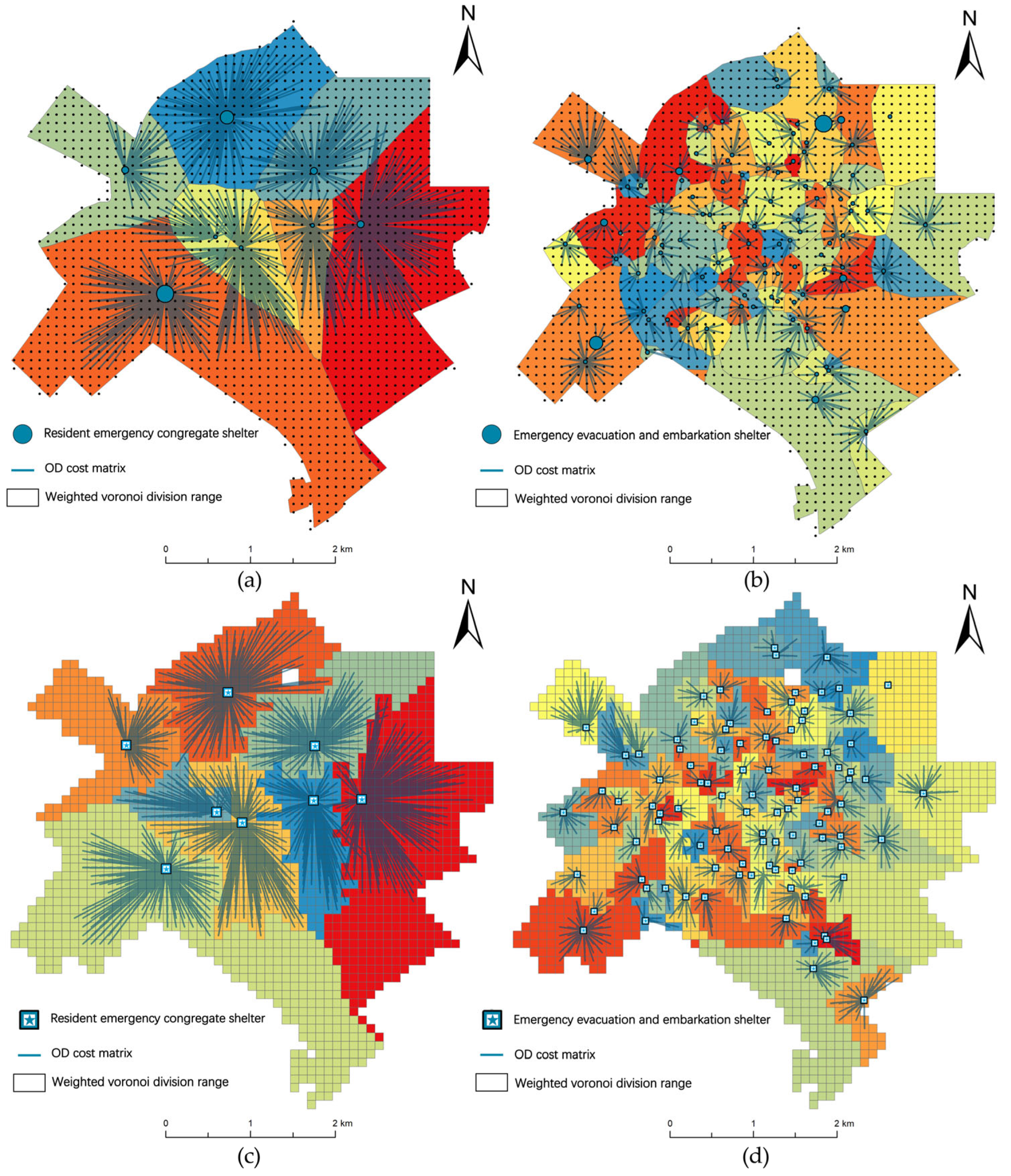
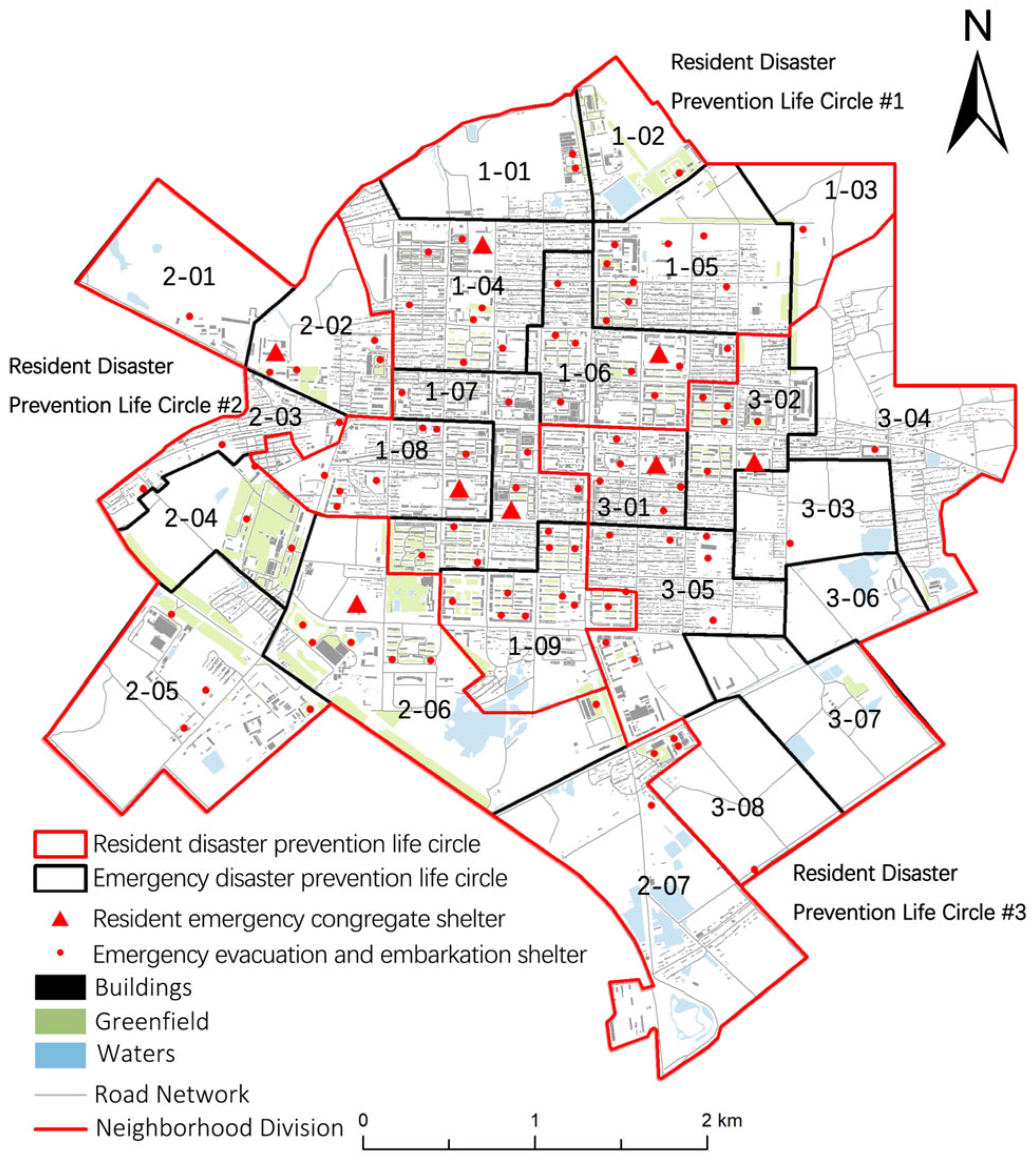
| Community Name | Number of Population/Person | Area/km2 | Population Density/(Persons-m2) |
|---|---|---|---|
| Southeast Community | 14,097 | 5.19 | 0.0027 |
| Southwest Community | 21,701 | 6.14 | 0.0035 |
| Northeast Community | 9864 | 3.59 | 0.0027 |
| Northwest Community | 13,338 | 3.33 | 0.0040 |
| Total | 59,000 | 18.25 | 0.0032 |
| Level of Shelter | Effective Refuge Area (hm2) | Evacuation Distance (m) | Site Size (km2) | Population Size (10,000) |
|---|---|---|---|---|
| Medium-term resident emergency congregate shelters | 1–5 | 1–1.5 | 1–7 | 3–15 |
| Short-term resident emergency congregate shelters | 0.2–1 | 0.5–1 | 0.8–3 | 0.2–3.5 |
| Emergency evacuation and embarkation shelters | Unlimited | 500 | Based on actual city construction | |
| Disaster Prevention Circle Level | Classification of Elements | Space Vehicle | Size Requirements |
|---|---|---|---|
| 15-min disaster prevention life circle | Resident emergency congregate shelter | Stadiums (including primary and secondary school playgrounds), parks and green spaces, and underground man-protected spaces | Service radius 2000 m, site 0.2–1.0 ha |
| 5–10 min disaster prevention life circle | Emergency evacuation and embarkation shelter | Community gardens, small squares, street green spaces, and concentrated green spaces in neighborhoods | The radius should not exceed 500 m, and the evacuation area per capita should not be less than 0.8 square meters |
| Number | Name of the Resident Emergency Congregate Shelter | Effective and Safe Area for Emergency Congregate Sheltering/m2 | Capacity Number of Evacuees/Person |
|---|---|---|---|
| 1 | Lindian County No.2 Middle School | 27,150 | 13,575 |
| 2 | Lindian County Dongfeng Middle School | 32,538 | 16,269 |
| 3 | Lindian County First Primary School | 23,383 | 11,691 |
| 4 | Lindian County Fourth Middle School | 24,596 | 12,298 |
| 5 | Lindian County Vocational Education Center | 31,064 | 15,532 |
| 6 | Lindian County Stadium | 43,124 | 21,562 |
| 7 | Tianxing Square | 20,078 | 10,039 |
| 8 | Harbin Essence Beer Plaza | 53,591 | 26,795 |
| Community Name | Resident Emergency Congregate Shelter | Emergency Evacuation and Embarkation Shelter | ||||
|---|---|---|---|---|---|---|
| Minimum Walking Time (min) | Maximum Walking Time (min) | Mean Walking Time (min) | Minimum Walking Time (min) | Maximum Walking Time (min) | Mean Walking Time (min) | |
| Southeast Community | 0.35 | 59.99 | 37.01 | 0.00 | 14.94 | 7.85 |
| Southwest Community | 1.03 | 59.87 | 33.21 | 0.00 | 14.95 | 7.53 |
| Northeast Community | 1.61 | 59.07 | 32.14 | 0.02 | 15.00 | 7.68 |
| Northwest Community | 1.49 | 59.80 | 27.40 | 0.00 | 14.81 | 7.14 |
| Types of Disaster Prevention and Shelter | Number of People to Be Covered (Persons) | Population Coverage (%) |
|---|---|---|
| Resident emergency congregate shelter | 45,935 | 77.86 |
| Emergency evacuation and embarkation shelter | 43,259 | 73.32 |
Disclaimer/Publisher’s Note: The statements, opinions and data contained in all publications are solely those of the individual author(s) and contributor(s) and not of MDPI and/or the editor(s). MDPI and/or the editor(s) disclaim responsibility for any injury to people or property resulting from any ideas, methods, instructions or products referred to in the content. |
© 2024 by the authors. Licensee MDPI, Basel, Switzerland. This article is an open access article distributed under the terms and conditions of the Creative Commons Attribution (CC BY) license (https://creativecommons.org/licenses/by/4.0/).
Share and Cite
Jiao, H.; Feng, S. Towards Resilient Cities: Optimizing Shelter Site Selection and Disaster Prevention Life Circle Construction Using GIS and Supply-Demand Considerations. Sustainability 2024, 16, 2345. https://doi.org/10.3390/su16062345
Jiao H, Feng S. Towards Resilient Cities: Optimizing Shelter Site Selection and Disaster Prevention Life Circle Construction Using GIS and Supply-Demand Considerations. Sustainability. 2024; 16(6):2345. https://doi.org/10.3390/su16062345
Chicago/Turabian StyleJiao, Hong, and Shining Feng. 2024. "Towards Resilient Cities: Optimizing Shelter Site Selection and Disaster Prevention Life Circle Construction Using GIS and Supply-Demand Considerations" Sustainability 16, no. 6: 2345. https://doi.org/10.3390/su16062345
APA StyleJiao, H., & Feng, S. (2024). Towards Resilient Cities: Optimizing Shelter Site Selection and Disaster Prevention Life Circle Construction Using GIS and Supply-Demand Considerations. Sustainability, 16(6), 2345. https://doi.org/10.3390/su16062345






